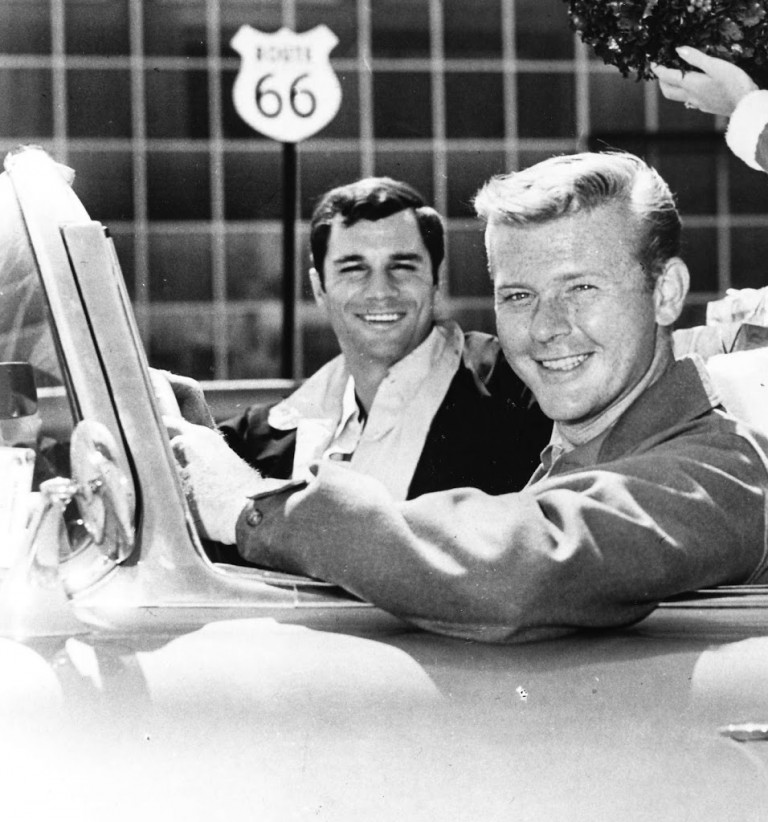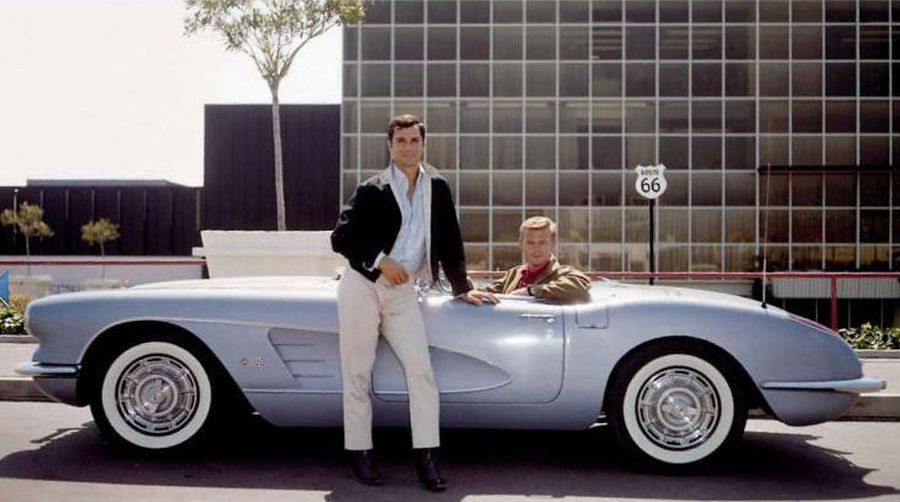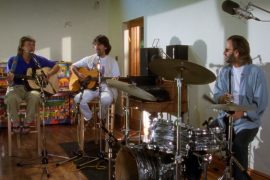
George Maharis has taken his final exit from Route 66.
I interviewed the actor on the phone in 2012 when he was promoting Route 66: The Complete Series, a 24 disc boxed set from Shout! Factory.
Maharis, 94, died May 24 at his home in Beverly Hills. A decade earlier, he spoke candidly about his days on location all over America — and even into Canada — on the 1960 to ’64 anthology series.
The show is probably best remembered today for its catchy theme song, by Nelson Riddle, as well as for its cool cars. General Motors were a sponsor and made sure the ’Vette was upgraded each season, though it was never explained how these two wanderers could afford such a car.
While he had spent a year on the daytime soap Search for Tomorrow, Maharis admitted he was still largely an unknown before Route 66 began.
“Marty [co-star Martin Milner, who had top billing] was much more established than I was. He started in movies as a child. I was fresh off Broadway.”
advertisement
Maharis was spotted in a play by producers Herbert B. Leonard and writer/producer Sterling Silliphant and was cast as an occasional guest star on their previous series, Naked City.
The word on Maharis has always been that he became a handful, that somewhere on the road to Detroit or Cleveland or Chicago or Buffalo or Miami or to any of the 40 States Route 66 traveled he went Hollywood. Maharis always maintained that he contracted hepatitis during the second season and could no longer cope with the grueling road schedule. He took time off under doctors orders, ventured back for part of the third season but finally decided the series just wasn’t worth putting his life at risk. He could always get another show, he figured. Another kidney, not so easy.
When I interviewed him in 2021, he did not get specific about his reputation during the series, but hinted that he did get caught up in the fame game. “I guess the best way to put it is, when you’re a young actor, you’re flying a Piper Cub, and all of a sudden they stick you in the cockpit of a 747 jet. You really can get killed quick because, all of a sudden, you’re in the fast lane.”
Maharis felt the producers never had his back when he got sick. “The mistake I made,” he says, “is that when you’re dealing with people on a higher level, you assume they are more honorable and trustworthy. I made the mistake of thinking that, as you went up the ladder, the morality got better.”
Stories spread that Maharis wanted out of the series to make movies. The head of CBS at the time, James Aubrey, told producer Leonard that Maharis was vital to the series and had to return. Maharis says he rushed back and had a relapse in St. Louis “and the doctors told me to go home or you’ll be dead.”

There were lawsuits and a settlement out of court. Route 66 was renewed for a fourth season with Glenn Corbett in the passenger seat next to Milner but it wasn’t the same. Ratings dropped and the series ended.
Medical documents from the time seem to vindicate Maharis’s version of events. “The culprit in all of this wasn’t ‘Bert, wasn’t Sterling, wasn’t James Aubrey, wasn’t George Maharis, it was hepatitis,” he says. “That changed everything.”
The chemistry between Maharis and Milner worked on the series because they were so opposite. Maharis’ Buz was the edgier guy, the roughneck from the streets of New York. Milner’s Tod was the college kid driving his dad’s cool car.
The series is fascinating today as a moving social history of the United States. A true anthology, every episode is set in a different city with different guest stars, including up and comers Robert Redford, Burt Reynolds, Gene Hackman, James Caan, Barbara Eden, Cloris Leachman, Ed Asner, Lee Marvin, Leslie Nielsen, Robert Duvall and Walter Matthau.
It is the train stations, hotels and downtown street scenes, however, that add a lost America feel to the series. Route 66 is a portrait of Mad Men America at mid-century, a cruise Don Draper could have made with Roger Sterling.
Maharis did have some fun during his three seasons on the series. He says meeting movie legends such as Buster Keaton, Boris Karloff, Peter Lorre and Lon Chaney, Jr., was a kick — although he was shocked at the language Lorre used on the set. “He swore up and down the line and the language that he used!” recalls Maharis. “I would never have suspected that.”
Karloff, Lorre and Chaney appeared together in the third season episode, “Lizard’s Leg and Owlet’s Wing.” The appearance marked the last time Karloff wore his old Frankenstein’s monster makeup.
A fourth season episode, with Corbett not Maharis, was shot in Toronto and provides a fascinating glimpse at the city in 1963. “A Long Way from St. Louie,” shows Tod and Linc (Milner and Corbett), staying at what was then the brand new Inn on the Park hotel in Toronto. They take off for a helicopter ride over the city, hovering over landmarks such as Old City Hall and Queen’s Park. There’s a glimpse of “new” City Hall, with the two curved towers under construction.
The chopper touches down at the old CNE Grandstand, where Tod and Linc come to the aide of a group of pretty young women who are jazz musicians. Among them is the late Jessica Walter — more famous today for playing scheming matriarch Lucille on Arrested Development.
Maharis is survived by an older brother, Harold, practically a twin, who worked on the show behind the camera. Sometimes Harold would drive the Corvette to and from location shoots when the actors flew on ahead to do publicity work. Recalls Maharis, “He’d stop off someplace to eat, get the bill and the cashier would say, ‘That’s okay Mr. Maharis, it’s on the house.’ By the time I got to town there was nothing left!”
When George would confront Harold about it, the brother would say, “Well, I am Mr. Maharis…”
Maharis was able to score one of the prized cars when he met with the sponsors and asked them if it was all right if he drove his own car to the various location shoots. Asked what he drove, Maharis told them it was a Ford Thunderbird.
A new Corvette was waiting for him at the studio the next week.






